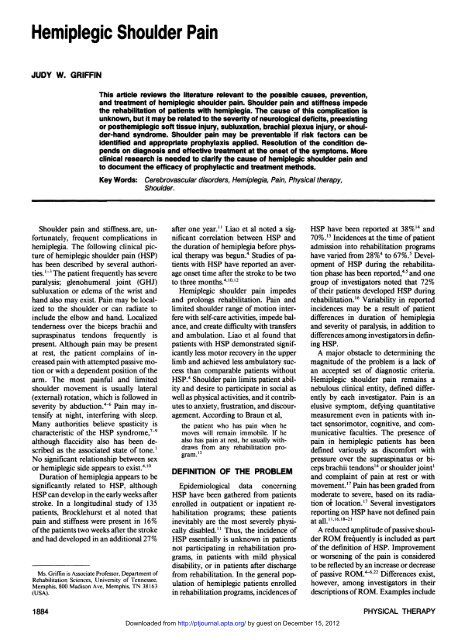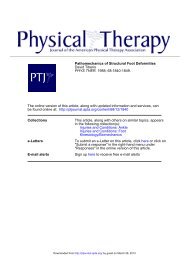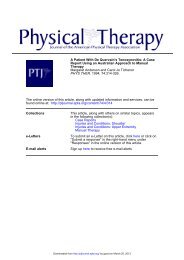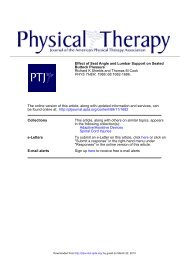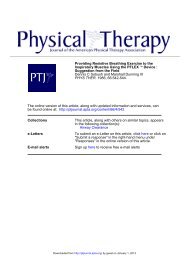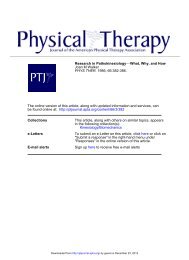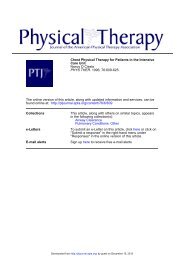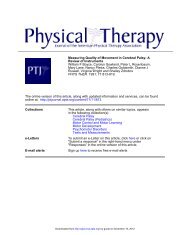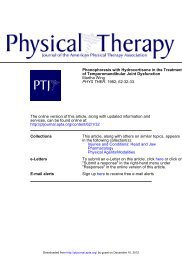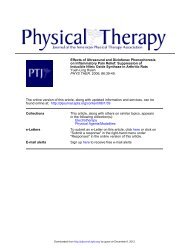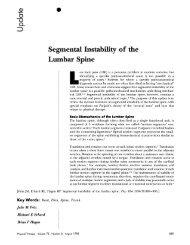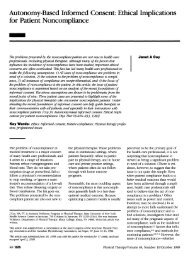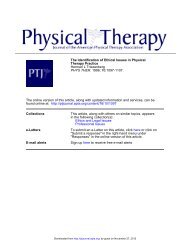Hemiplegic Shoulder Pain - Physical Therapy
Hemiplegic Shoulder Pain - Physical Therapy
Hemiplegic Shoulder Pain - Physical Therapy
Create successful ePaper yourself
Turn your PDF publications into a flip-book with our unique Google optimized e-Paper software.
<strong>Hemiplegic</strong> <strong>Shoulder</strong> <strong>Pain</strong><br />
JUDY W. GRIFFIN<br />
<strong>Shoulder</strong> pain and stiffness.are, unfortunately,<br />
frequent complications in<br />
hemiplegia. The following clinical picture<br />
of hemiplegic shoulder pain (HSP)<br />
has been described by several authorities.<br />
1-3 The patient frequently has severe<br />
paralysis; glenohumeral joint (GHJ)<br />
subluxation or edema of the wrist and<br />
hand also may exist. <strong>Pain</strong> may be localized<br />
to the shoulder or can radiate to<br />
include the elbow and hand. Localized<br />
tenderness over the biceps brachii and<br />
supraspinatus tendons frequently is<br />
present. Although pain may be present<br />
at rest, the patient complains of increased<br />
pain with attempted passive motion<br />
or with a dependent position of the<br />
arm. The most painful and limited<br />
shoulder movement is usually lateral<br />
(external) rotation, which is followed in<br />
severity by abduction. 4-6 <strong>Pain</strong> may intensify<br />
at night, interfering with sleep.<br />
Many authorities believe spasticity is<br />
characteristic of the HSP syndrome, 7-9<br />
although flaccidity also has been described<br />
as the associated state of tone. 1<br />
No significant relationship between sex<br />
or hemiplegic side appears to exist. 4,10<br />
Duration of hemiplegia appears to be<br />
significantly related to HSP, although<br />
HSP can develop in the early weeks after<br />
stroke. In a longitudinal study of 135<br />
patients, Brocklehurst et al noted that<br />
pain and stiffness were present in 16%<br />
of the patients two weeks after the stroke<br />
and had developed in an additional 27%<br />
Ms. Griffin is Associate Professor, Department of<br />
Rehabilitation Sciences, University of Tennessee,<br />
Memphis, 800 Madison Ave, Memphis, TN 38163<br />
(USA).<br />
This article reviews the literature relevant to the possible causes, prevention,<br />
and treatment of hemiplegic shoulder pain. <strong>Shoulder</strong> pain and stiffness impede<br />
the rehabilitation of patients with hemiplegia. The cause of this complication is<br />
unknown, but it may be related to the severity of neurological deficits, preexisting<br />
or posthemiplegic soft tissue injury, subluxation, brachial plexus injury, or shoulder-hand<br />
syndrome. <strong>Shoulder</strong> pain may be preventable if risk factors can be<br />
identified and appropriate prophylaxis applied. Resolution of the condition depends<br />
on diagnosis and effective treatment at the onset of the symptoms. More<br />
clinical research is needed to clarify the cause of hemiplegic shoulder pain and<br />
to document the efficacy of prophylactic and treatment methods.<br />
Key Words: Cerebrovascular disorders, Hemiplegia, <strong>Pain</strong>, <strong>Physical</strong> therapy,<br />
<strong>Shoulder</strong>.<br />
after one year. 11 Liao et al noted a significant<br />
correlation between HSP and<br />
the duration of hemiplegia before physical<br />
therapy was begun. 4 Studies of patients<br />
with HSP have reported an average<br />
onset time after the stroke to be two<br />
to three months. 4,10,12<br />
<strong>Hemiplegic</strong> shoulder pain impedes<br />
and prolongs rehabilitation. <strong>Pain</strong> and<br />
limited shoulder range of motion interfere<br />
with self-care activities, impede balance,<br />
and create difficulty with transfers<br />
and ambulation. Liao et al found that<br />
patients with HSP demonstrated significantly<br />
less motor recovery in the upper<br />
limb and achieved less ambulatory success<br />
than comparable patients without<br />
HSP. 4 <strong>Shoulder</strong> pain limits patient ability<br />
and desire to participate in social as<br />
well as physical activities, and it contributes<br />
to anxiety, frustration, and discouragement.<br />
According to Braun et al,<br />
the patient who has pain when he<br />
moves will remain immobile. If he<br />
also has pain at rest, he usually withdraws<br />
from any rehabilitation program.<br />
13<br />
DEFINITION OF THE PROBLEM<br />
Epidemiological data concerning<br />
HSP have been gathered from patients<br />
enrolled in outpatient or inpatient rehabilitation<br />
programs; these patients<br />
inevitably are the most severely physically<br />
disabled. 11 Thus, the incidence of<br />
HSP essentially is unknown in patients<br />
not participating in rehabilitation programs,<br />
in patients with mild physical<br />
disability, or in patients after discharge<br />
from rehabilitation. In the general population<br />
of hemiplegic patients enrolled<br />
in rehabilitation programs, incidences of<br />
HSP have been reported at 38% 14 and<br />
70%. 15 Incidences at the time of patient<br />
admission into rehabilitation programs<br />
have varied from 28% 4 to 67%. 5 Development<br />
of HSP during the rehabilitation<br />
phase has been reported, 4,5 and one<br />
group of investigators noted that 72%<br />
of their patients developed HSP during<br />
rehabilitation. 16 Variability in reported<br />
incidences may be a result of patient<br />
differences in duration of hemiplegia<br />
and severity of paralysis, in addition to<br />
differences among investigators in defining<br />
HSP.<br />
A major obstacle to determining the<br />
magnitude of the problem is a lack of<br />
an accepted set of diagnostic criteria.<br />
<strong>Hemiplegic</strong> shoulder pain remains a<br />
nebulous clinical entity, defined differently<br />
by each investigator. <strong>Pain</strong> is an<br />
elusive symptom, defying quantitative<br />
measurement even in patients with intact<br />
sensorimotor, cognitive, and communicative<br />
faculties. The presence of<br />
pain in hemiplegic patients has been<br />
defined variously as discomfort with<br />
pressure over the supraspinatus or biceps<br />
brachii tendons 14 or shoulder joint 1<br />
and complaint of pain at rest or with<br />
movement. 17 <strong>Pain</strong> has been graded from<br />
moderate to severe, based on its radiation<br />
or location. 17 Several investigators<br />
reporting on HSP have not defined pain<br />
at all. 11,16,18-21<br />
A reduced amplitude of passive shoulder<br />
ROM frequently is included as part<br />
of the definition of HSP. Improvement<br />
or worsening of the pain is considered<br />
to be reflected by an increase or decrease<br />
of passive ROM. 4-6,22 Differences exist,<br />
however, among investigators in their<br />
descriptions of ROM. Examples include<br />
1884 PHYSICAL THERAPY<br />
Downloaded from<br />
http://ptjournal.apta.org/ by guest on December 15, 2012


